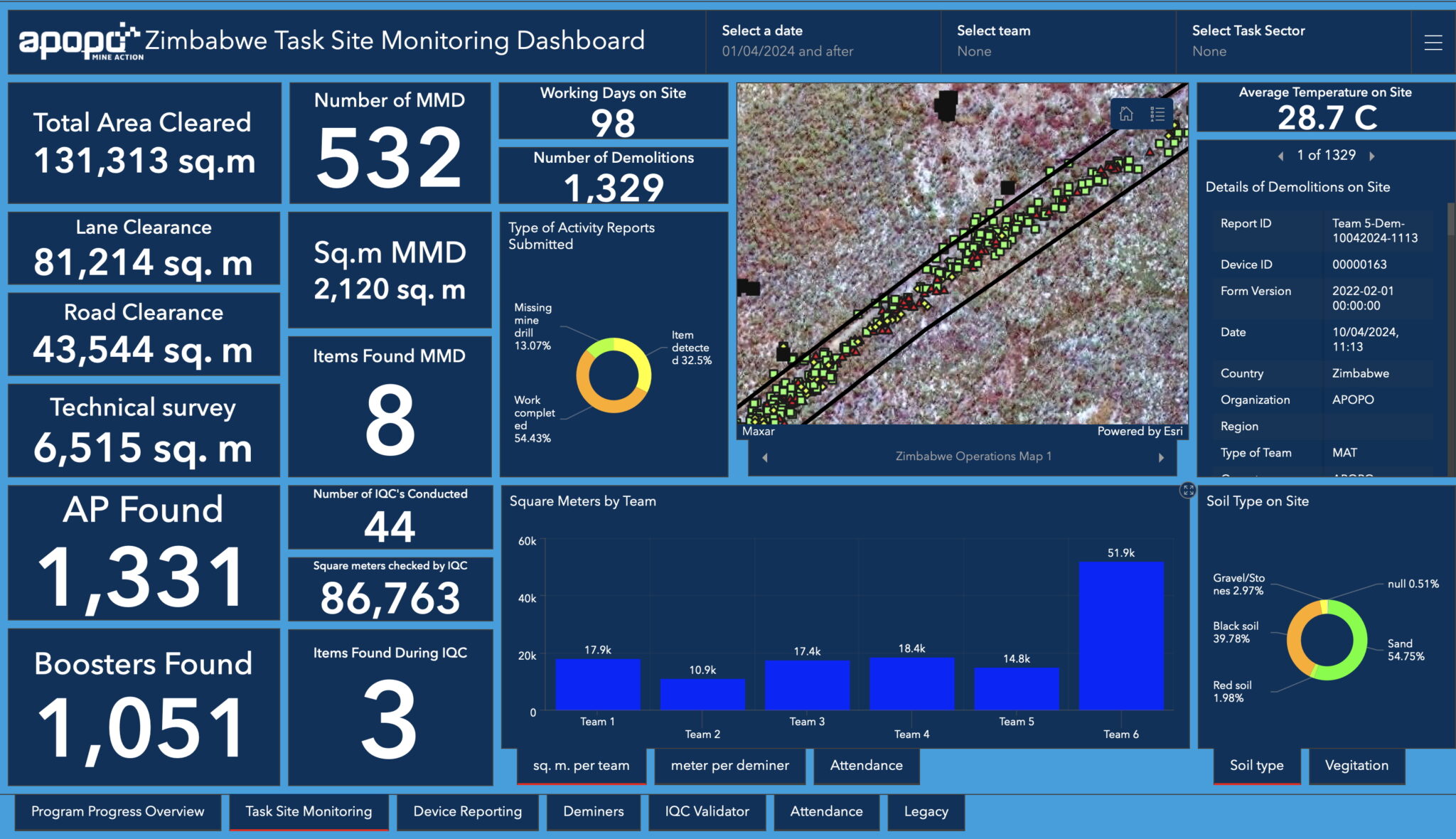Following a field trial between September 2023 and March 2024, APOPO Zimbabwe revised its mine action data collection methods to mitigate mine clearance risks by incorporating a Clearance Data Model (CDM) into daily reporting. The aim was to explore how this updated method could improve the quality of collected data whilst also saving time for demining Team Leaders managing and monitoring clearance teams of six deminers.

The CDM was developed by Roland Evans, a PhD student at Cranfield University, Defence and Security in the United Kingdom. The CDM, part of an overall approach termed “operational data” has other operational data models under consideration, which include the Survey Data Model, that does the equivalent for evidence found in the field on which key land release decisions are made. APOPO conducted the field trial on behalf of Cranfield University during live mine clearance operations in Zimbabwe. The CDM involved the collection of sixty-six data points for each of the 875 landmines found during the trial period.
By using the CDM, for the first time, the landmines themselves became the accountable unit of demining data, against which an expanded range of relevant attributes particular to that specific landmine would be recorded. These include location, environment, process, device type and image categories. This new approach expands considerably on the standard operational data collected about landmines, which traditionally has been focused on minimal data collection.
The trial proved that it is practical to collect this level of data without affecting operational efficiency as well as demonstrating the practicality of using tablets for efficient field data collection. It also showed that such data has significant benefits for quantitative operational risk management, as well as overall operations and quality management. Risk management is vital for mine action organizations to foresee, plan for and address potential safety challenges in the most effective way possible.
Since April 2024, APOPO in Zimbabwe has moved away from traditional end-of-the-day reporting for the whole demining team. APOPO’s reporting is now activity-based, meaning that when an individual deminer completes an activity, it is recorded in real-time.
The Importance of Output Monitoring in Mine Action
Output monitoring is crucial for risk management in mine action, offering real-time insights into operational effectiveness and safety. By continuously tracking performance and progress, each Demining Program can swiftly identify issues and inefficiencies, enabling timely corrective actions. This proactive approach mitigates risks related to safety, quality, and efficiency by allowing for more timely and precise corrective measures and training for field members, while ensuring compliance with regulations and enhancing accountability. Ultimately, it supports data-driven decision-making, which is essential for navigating uncertainties in complex environments.

The New Activity-Based Reporting Model’s Innovations
The new method of data collection using the new activity-based approach for individual deminers compared to traditional end-of-day reporting for a whole demining team is now conducted in “real-time”. This means that data is gathered immediately whenever a deminer finishes clearance in a lane. If the deminer finds a landmine that will have to be destroyed at the end of the day by demolition in situ by the Team Leader, APOPO can now link different activities and processes associated with a landmine.
In order to link data for the activities conducted by each deminer APOPO introduced barcodes associated with each landmine that are scanned at the beginning and end of each activity.
Since March 2024 APOPO’s system has gathered 20,000 data points per day, which is the equivalent of more than 4,000,000 data points per year. This is made possible due to the fact that around 70% of the data points are auto-populated, calculated, or pulled from defaulted data fields. Overall, APOPO has found that less than 20% of team leaders’ time is spent on data collection under this system.

Expected Future Expansion of APOPO’s Innovative Data Collection Method
The operational field evaluation of the activity-based reporting model has now entered its final phase of exploring what sustainable data to collect for operational monitoring of performance metrics, productivity, quality control, and resource utilization. This will allow us to identify areas for improvement, optimize workflows, and maintain our high operational standards in mine clearance activities.
The resulting data has been shown to enable quantitative mine clearance risk assessment for field operations. The trial proved that it is practical to devote more operational time to collect an expanded data set based on each individual landmine and that the resulting data enables vastly improved risk, quality and overall operations management.
In 2025, APOPO intends to incorporate this output monitoring model to its other programs such as those in Cambodia, Angola, and Azerbaijan.
APOPO’S data innovation would not have been possible without the support of the US Department of State’s Office of Weapons Removal and Abatement (WRA) as well as the crucial support from the US Humanitarian Demining Research and Development Program (HDRD) for technology research and development.
APOPO Mine Action Zimbabwe is most grateful to our partners and donors for making our work possible:


